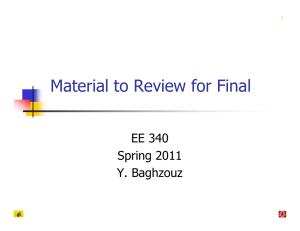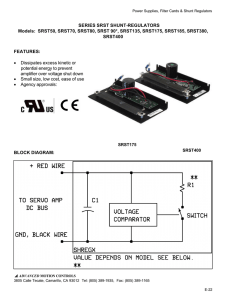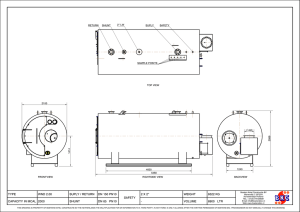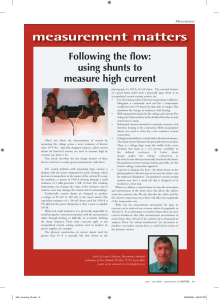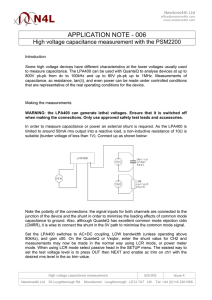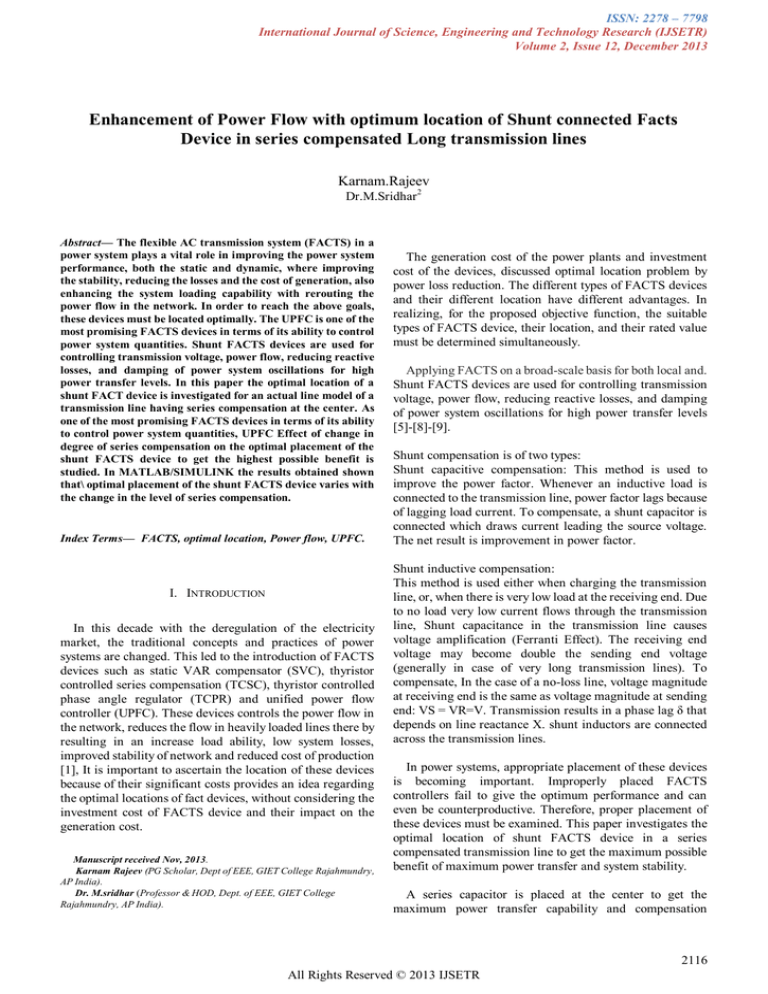
ISSN: 2278 – 7798
International Journal of Science, Engineering and Technology Research (IJSETR)
Volume 2, Issue 12, December 2013
Enhancement of Power Flow with optimum location of Shunt connected Facts
Device in series compensated Long transmission lines
Karnam.Rajeev
Dr.M.Sridhar 2
Abstract— The flexible AC transmission system (FACTS) in a
power system plays a vital role in improving the power system
performance, both the static and dynamic, where improving
the stability, reducing the losses and the cost of generation, also
enhancing the system loading capability with rerouting the
power flow in the network. In order to reach the above goals,
these devices must be located optimally. The UPFC is one of the
most promising FACTS devices in terms of its ability to control
power system quantities. Shunt FACTS devices are used for
controlling transmission voltage, power flow, reducing reactive
losses, and damping of power system oscillations for high
power transfer levels. In this paper the optimal location of a
shunt FACT device is investigated for an actual line model of a
transmission line having series compensation at the center. As
one of the most promising FACTS devices in terms of its ability
to control power system quantities, UPFC Effect of change in
degree of series compensation on the optimal placement of the
shunt FACTS device to get the highest possible benefit is
studied. In MATLAB/SIMULINK the results obtained shown
that\ optimal placement of the shunt FACTS device varies with
the change in the level of series compensation.
Index Terms— FACTS, optimal location, Power flow, UPFC.
I. INTRODUCTION
In this decade with the deregulation of the electricity
market, the traditional concepts and practices of power
systems are changed. This led to the introduction of FACTS
devices such as static VAR compensator (SVC), thyristor
controlled series compensation (TCSC), thyristor controlled
phase angle regulator (TCPR) and unified power flow
controller (UPFC). These devices controls the power flow in
the network, reduces the flow in heavily loaded lines there by
resulting in an increase load ability, low system losses,
improved stability of network and reduced cost of production
[1], It is important to ascertain the location of these devices
because of their significant costs provides an idea regarding
the optimal locations of fact devices, without considering the
investment cost of FACTS device and their impact on the
generation cost.
Manuscript received Nov, 2013.
Karnam Rajeev (PG Scholar, Dept of EEE, GIET College Rajahmundry,
AP India).
Dr. M.sridhar (Professor & HOD, Dept. of EEE, GIET College
Rajahmundry, AP India).
The generation cost of the power plants and investment
cost of the devices, discussed optimal location problem by
power loss reduction. The different types of FACTS devices
and their different location have different advantages. In
realizing, for the proposed objective function, the suitable
types of FACTS device, their location, and their rated value
must be determined simultaneously.
Applying FACTS on a broad-scale basis for both local and.
Shunt FACTS devices are used for controlling transmission
voltage, power flow, reducing reactive losses, and damping
of power system oscillations for high power transfer levels
[5]-[8]-[9].
Shunt compensation is of two types:
Shunt capacitive compensation: This method is used to
improve the power factor. Whenever an inductive load is
connected to the transmission line, power factor lags because
of lagging load current. To compensate, a shunt capacitor is
connected which draws current leading the source voltage.
The net result is improvement in power factor.
Shunt inductive compensation:
This method is used either when charging the transmission
line, or, when there is very low load at the receiving end. Due
to no load very low current flows through the transmission
line, Shunt capacitance in the transmission line causes
voltage amplification (Ferranti Effect). The receiving end
voltage may become double the sending end voltage
(generally in case of very long transmission lines). To
compensate, In the case of a no-loss line, voltage magnitude
at receiving end is the same as voltage magnitude at sending
end: VS = VR=V. Transmission results in a phase lag δ that
depends on line reactance X. shunt inductors are connected
across the transmission lines.
In power systems, appropriate placement of these devices
is becoming important. Improperly placed FACTS
controllers fail to give the optimum performance and can
even be counterproductive. Therefore, proper placement of
these devices must be examined. This paper investigates the
optimal location of shunt FACTS device in a series
compensated transmission line to get the maximum possible
benefit of maximum power transfer and system stability.
A series capacitor is placed at the center to get the
maximum power transfer capability and compensation
2116
All Rights Reserved © 2013 IJSETR
ISSN: 2278 – 7798
International Journal of Science, Engineering and Technology Research (IJSETR)
Volume 2, Issue 12, December 2013
efficiency for the selected rating of the shunt FACTS device.
The shunt FACTS device is operated at that
Devices in which the reactive power producer is the
power electronic converter itself. These devices do
not have any capacitors or inductors as reactive
power elements. The STATCOM, SCRC and UPFC
belong to this category.
According to their application, FACTS devices can be
categorized as shunt compensators, series compensators or
both shunt-series compensators. Each type of FACTS device
has a different impact on the overall system performance [4]
(Table 1).
Table 1: Impact of FACTS devices on system performance.
Figure 1: Shunt Compensation.
The rating of a shunt FACT device is selected in such a way
so as to control the voltage equal to sending end voltage at the
bus of the shunt FACT device. It is observed that the optimal
location of a shunt FACT device deviates from the center of
the line towards the generator side with the increase in the
degree of series Compensation.
III. TRANSMISSION LINE MODEL
In this study, it is considered that the transmission line
parameters are uniformly distributed and the line can be
modeled by a 2-port, 4-terminal networks as shown in Figure
3. This figure represents the actual line model. The
relationship between sending end (SE) and receiving end
(RE) quantities of the line can be written as:
Figure 2: series Compensation.
rating that is able to control the bus voltage of shunt FACTS
device equal to sending end voltage so as to get the maximum
possible benefit of maximum power transfer and stability
under steady state conditions.
II. FACT DEVICES
Figure 3: 2-port, 4-terminal transmission line model.
A. Unified Power Flow Concept (UPFC)
It is known that the power transfer limit and the quality of
supply can be drastically improved by insertion of voltage or
current into a power system. This can be achieved by use of
power electronics switches and converters. The technology is
called Flexible AC Transmission System (FACTS) [1]-[3].
FACTS devices are usually classified into two groups
depending on how they generate reactive power:
Devices which have an inductor or a capacitor as
reactive elements being controlled by power
electronic switches, e.g. Static Var Compensator
(SVC), Thyristor Controlled Series Capacitor
(TCSC),
Figure 4: Basic Structure of an UPFC.
2117
All Rights Reserved © 2013 IJSETR
ISSN: 2278 – 7798
International Journal of Science, Engineering and Technology Research (IJSETR)
Volume 2, Issue 12, December 2013
The UPFC consists of a series and a shunt converter is
connected back-to-back through a common dc link. The
shunt converter is connected also in parallel with the line
transmission by transformer, allows controls the UPFC bus
Voltage/shunt reactive power and the dc capacitor voltage.
B.
The ABCD Constants of a line of length 1, having a series
impedance of Z ohm/km and shunt admittance of y S/km, are
given by
(3)
Where
and
The active and reactive power flows at the SE and RE of the line
can be written as
C.
D.
E.
F.
Figure 5: Shunt FACT devices with series compensated
transmission line model.
It is supposed that the rating of the shunt FACTS device is
large enough to supply the reactive power required to
maintain a constant voltage magnitude at bus m and the
device does not absorb or supply any active power.
Where
It is clear from Eq. (6) that the RE power reaches the
maximum value when the angle δ becomes β. However, the
SE power PS of Eq. (4) becomes maximum at δ = (Π− β). In
this study, a 735 kV single circuit transmission line (300 km
in length), is considered. It is assumed that each phase of line
has a bundle of 2 conductors of size one million c-mils each
and conductors are fully transposed.
B. Series Compensated with shunt FACT devices in
Transmission
Consider that the line is transferring power from a large
generating station to an infinite bus and equipped with series
capacitor at center and a shunt FACT device at point „m‟ as
shown in Figure 2. Parameter k is used to show the fraction of
the line length at which the FACTS device is placed. The
shunt FACTS device may be a SVC or STATCOM and is
usually connected to the line through a step-down
transformer as shown in Figures 3 and 4. The transmission
line is divided into 2 sections (1 & 2), and section 2 is further
divided in subsections of length [(0.5-k) & half-line length].
Each section is represented by a separate 2-port, 4-terminal
network (similar to Figure 2) with its own ABCD constants
considering the actual line model
Figure 6: Examples of FACTs devices.
III. MAXIMUM POWER TRANSFER CAPABILITY
For a simplified model, when there is no FACTS device
connected to the line, maximum power transfer through the
line is given by [3]:
(8)
Many researchers established that the optimal location of
shunt FACTS device for a simplified model is at K= 0.5
when there is no series compensation in the line. For such
cases maximum power transmission capability (Pm) and
maximum transmission angle ( δ m) become double.
However, for an actual line model power flow is given by
Eqs. (4) and (6) instead of Eq. (8) and the above results may
not be considered accurate. One of the objectives of this paper
is to find the maximum power and corresponding location of
shunt FACTS device for different series compensation levels
(%S) located at the center of the line. A sophisticated
computer program was developed to determine the various
characteristics of the system of Figure 5 using an actual
model of the line sections.
2118
All Rights Reserved © 2013 IJSETR
ISSN: 2278 – 7798
International Journal of Science, Engineering and Technology Research (IJSETR)
Volume 2, Issue 12, December 2013
Figure 7: Schematic diagram of SVC.
IV. MODELING AND SIMULATION RESULTS
Figure 8 shows the Modeling of series compensated with
shunt FACTs device for optimal location in long
transmission line.
Figure 9: Variation in maximum SE power for diff. value of
%S.
From Figure 7 it can be noted that when %S = 0 the value of
increases as the value of (K) is increased from zero and
reaches the maximum value of 18.5 p.u. at K = 0.45 (but not
at K = 0.5). Slope of the
curve suddenly changes at K=
0.45 and the value of
decreases when K > 0.45. A similar
pattern for
can be observed from Figure 6 when (%S = 0).
When series compensation in the line is taken into account,
we observe that the optimal location of the shunt FACTS
device will change and shifts towards the generator side. As
seen from Figure 7, when %S = 15 then
increases from
12.5 p.u. (at K = 0) to its maximum value 22 p.u. (at K =
0.375). When K is further increased then
decreases. It
means that, for maximum power transfer capability, the
optimal location of the shunt device will change when series
compensation level changes. When %S = 30, the optimal
location further shifts to the generator side and
increases
from 15.2 p.u. (at K = 0) to its maximum value 26.8 p.u. (at K
= 0.3).
Figure 8: Modelling of Three phase series compensated with
shunt FACT devices.
The constant of the same RE power of section (1) and SE
power of section (2) (PR1 = PS2) is incorporated into the
problem. In all cases, VS = VR = VM = 1.0 p.u. unless
specified. The maximum power Pm and corresponding angle
δm are prior determined for various values of location (K).
Figures 6-9 show the variation in maximum RE power (
), maximum sending end power, and transmission angle (δm)
at the maximum sending end power, respectively, against (K)
for different series compensation levels (%S). It can be
noticed from Figures 6 and 7 that
>
for any series
compensation level (%S) because of the loss in the line.
Figure 10: Variation in maximum RE power for diff. value of
%S.
Similarly, when %S = 45, we obtain the optimal location of
the shunt device at K = 0.225. A similar pattern for
can
be observed from Figure 6 for different series compensation
levels. In Figure 9, it can be observed that in the absence of
series compensation (%S = 0) the angle at the maximum SE
power increases from 95.8o at K = 0 to its maximum value
2119
All Rights Reserved © 2013 IJSETR
ISSN: 2278 – 7798
International Journal of Science, Engineering and Technology Research (IJSETR)
Volume 2, Issue 12, December 2013
171.1o at K = 0.45. When %S = 15 then δm increases when K
is increased and reaches its maximum value 180.5o at K =
0.375. When %S = 30 then δm increases when K is increased
and reaches its maximum value 185o at K = 0.3 and for %S=
45 it is 188o for K = 0.225. As the degree of series
compensation level (%S) increases, the stability of the system
increases and the optimal location of the shunt FACTS
device changes.
increased then the optimal location of the shunt device shifts
towards the generator side.
Figure 11: Variation in the optimal off-center location of
shunt FACTS device against degree of compensation of line
(%S).
Figure 11: Variation in transmission angle at the max. SE
power for diff %S.
Optimal location of Shunt FACT Devices, Figure 8 shows the
variation of the maximum RE power of section 1 (PR1m) and
maximum SE power of section 2 (PS2m) against the value of
K for different series compensation levels (%S). It can be
seen in Figure 8 that for an uncompensated line then
maximum power curves cross at K = 0.45 and the crossing
point is the transition point.
Figure 12: Variation in the maximum RE power of section-1
and SE power of section-2 against k for diff. value of %S.
Thus, to get the highest benefit in terms of maximum power
transfer capability and system stability, the shunt
FACTS device must be placed at K = 0.45, which is slightly
off- center. When the series compensation level is taken into
account then for %S = 15 the maximum power curves cross at
K = 0.375 and maximum power transfer capability increases.
It means that when series compensation level (%S) is
Similarly when %S = 30 then the optimal location is at K =
0.3 and for %S = 45 it is at K = 0.25. Figure 12 shows the
variation in optimal off-center location of the shunt FACTS
device against the degree of series compensation level (%S)
for the given R/X ratio of the line. It can be observed in
Figure 12 that the optimal off-center location is 10% for the
uncompensated line. When series compensation level (%S) is
increased than optimal off-center location increases linearly
and reaches its highest value 55% for %S = 45. Operation of
the UPFC demands proper power rating of the series and
shunt branches. The rating should enable the UPFC carrying
out pre-defined power flow objective.
V. CONCLUSION
This paper investigates the effect of series compensation on
the optimal location of a shunt FACTS device to get the
highest possible benefit of maximum power transfer and
system stability. Various results were found for an actual line
model of a series compensated 735 kV, 300 km line. It has
been found that the optimal location of the shunt FACTS
device is not fixed as reported by many researchers in the
case of uncompensated lines but it changes with the change
in degree of series compensation. The deviation in the
optimal location of the shunt FACT device from the center
point of line depends upon the degree of series compensation
and it increases almost linearly from the center point of the
transmission line towards the generator side as the degree of
series compensation (%S) is increased. Both the power
transfer capability and stability of the system can be
improved much more if the shunt FACTS device is placed at
the new optimal location instead of at the mid-point of the
line.
REFERENCES
[1] Gyugyi, L. 1995, ”Unified power flow controller concept for flexible AC
Transmission system”, IEEE Proceedings- Volume 10, Issue 2, Apr 1995.
[2] M.H. Haque,2000, “Optimal location of shunt FACTS devices in long
transmission line”, IEE Proceedings on Generation Transmission &
Distribution, Vol. 147, No. 4, pp. 218-22, 2000.
2120
All Rights Reserved © 2013 IJSETR
ISSN: 2278 – 7798
International Journal of Science, Engineering and Technology Research (IJSETR)
Volume 2, Issue 12, December 2013
[3] Narain G. Hingorani, Laszlo Gyugyi , 1999, Understanding FACTS:
Concepts and Technology of Flexible AC Transmission Systems,
Wiley-IEEE Press, December 1999.
[4] N.G. Hingorani, L. Gyugyi, Understanding FACTS, Concept and
Technology of Flexible AC Transmission Systems, NewY ork, Wiley,
2000.
[5] Xiao-Ping Zhang, Christian Rehtanz, Bikash Pal, 2006, Flexible AC
Transmission Systems: Modelling and Control,Springer, March 2006.
[6] P. Kundur, 1994, Power system stability and control, EPRI Power System
Engineering Series, New York, McGraw-Hill Inc.,
[7] A. Edris, R. Adapa, M.H. Baker, L. Bohmann, K. Clark, K. Habashi, L.
Gyugyi, J. Lemay, A. Mehraban, A.K. Myers, J. Reeve, F. Sener, D.R.
Torgerson, R.R. Wood, Proposed Terms and Definitions for Flexible AC
Transmission System (FACTS), IEEE Transactions on Power Delivery,
Vol. 12, No. 4, October 1997.
[8] Tate J.E and Thomas J.Overbye, 2005, “A Comparison of the Optimal
Multiplier in Polar and Rectangular Coordinates” IEEE Transactions on
Power systems, Vol.20,No 4.
[9] G.H. Hingorani, “flexible AC transmission system”, IEEE spectrum, Apr
1993.
[10] F. Milano, "An Open Source Power System Analysis Toolbox, "IEEE
Trans. on Power Systems, Vol. 20, No. 3, pp. 1199-1206, August 2005.
[11] M. Saravanan, S. M. R. Slochanal, P. Venkatesh, J. P. S. Abraham,
“Application of particle swarm optimization technique for optimal location
of FACTS devices considering cost of installation and system loadability”,
IEEE-2000.
2121
All Rights Reserved © 2013 IJSETR

